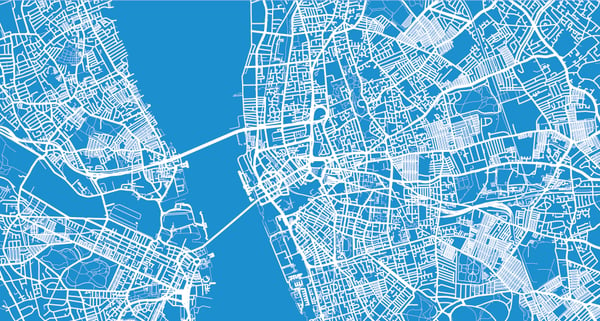
Let's face it, the digital maps of today are amazing. Without being dramatic, it could easily be said that responsive mapping software is one of the greatest inventions for field services since the cargo net.
Thirty years ago and for thousands of years before that, your best bet getting from Point A to Point B was to know where you were starting and have your own local road atlas at all times.
Some field services tried to make do with a single map of the city posted on a wall in HQ and the drivers had to try and remember the way from that one mental picture.
While field service has it good right now with easy navigation and route management through apps and online resources, a walk down memory lane can help highlight just how good things have gotten. And how much better they can get.
A Brief History of Digital Maps
The MapQuest Era
Twenty years ago, back in the MapQuest days, finally everyone had access to digital maps. It was amazing to be able to search a route, decide the best path, and print out the exact directions needed to get there.
Like having a friend who always knew the way and wrote down legible, perfect instructions. We felt so free taking our printed instruction pages on the road, able to know for sure, turn by turn, which street was correct.
It didn't matter that you had to log into your office or home computer, print out the directions, and carry them with you. It was better than an atlas and directions scrawled on napkins. Field service trucks, delivery drivers, and road trippers everywhere rejoiced, not knowing how much better it could get.
Downsides
Despite the joy, there were plenty of downsides to the MapQuest era of navigation. Mainly, that someone had to hold and read the direction. In many cases, this meant printer paper clutched in the driver's hand as they maneuver through traffic.
In instances of good field service teamwork, a passenger can take on the navigator role, delivering timely instructions like the Betties and AIs we know today.
The Rise of GPS Devices
In the early 2000s, new devices started appearing on the market, bulky little computer screens to mount in your car called GPS navigation devices.
Now GPS wasn't a new invention, but with cellphones on the rise (not yet smart), computers were getting smaller and it became possible to combine the digital mapping technology that had been floating around on the internet (and in some industry software) with a real-time locational tracker and a helpful 'minimap'.
Combine this with a voice to give hands-free step-by-step directions. This hit the driving world like a well-mannered storm.
Luxury cars had GPS navigation devices and the consumer world was consumed by the Tom-Tom vs Garmin war and flame wars over which celebrity voice pack was best. Meanwhile, the field service industry was quietly installing the most efficient devices available into every work vehicle.
Drivers were safer because they weren't clutching and trying to read paper instructions and the mini-map gave you an idea of how to detour if there was a problem with the route. This allowed for more complex routes without stopping in at HQ, more scheduling flexibility, and faster route planning on-the-go for field service teams in every specialization.
Downsides
For anyone who remembers working with the 00s era GPS devices, the downsides of this navigation era were all too evident. Not only were the automated voices often irritating (hence the celebrity variations), but they were also not the fastest little computers in the world.
Unfortunately, lag in updating the display or redirecting a route lead to a lot of missed turns and fighting with your GPS was a good way to miss a stoplight. They were also not excellent at routing and there was little recourse if the GPS did not know your destination. Fortunately, digital mapping had a lot further to go.
Smartphones and Navigation Apps
Then smartphones came along, an amazing innovation in the once-diverse phone industry, encouraging software unification and ushering in the mobile app era.
Navigation apps began to pop up but didn't start the overwhelming change in how people navigated until about 2013 when Google Maps was released on the app store.
At the same time, Google and other mapping companies were quickly expanding their pathing data, improving their software quality, and upgrading the Betty personalities.
For field service, this was a logistics bonanza. With either company or BYOD phones, drivers could now mount a very small GPS-capable device on the dash and receive interactive instructions.
No one-purpose device to tangle with, networking from anywhere with cell service, and a steadily increasing number of helpful features that add to the field service experience.
But that's just using consumer-level software. With Google Maps exporting it's excellent API to thousands of individual software developers, there are now many specialized ways to make use of the already helpful technology.
Needless to say, the field service industry has a lot to gain from even further fine-tuning the digital mapping trend for our purposes.
[To be Continued! ... contact us ]







